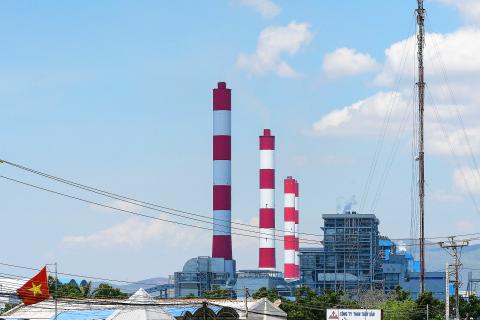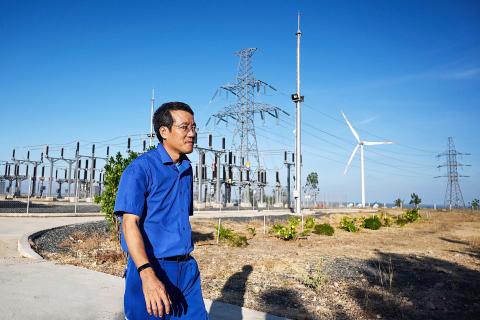Toothless and nearly blind, grandmother Pham Thi Ca refuses to leave her plot of land even after bulldozers demolished her house — an extraordinary holdout against communist Vietnam’s deepening addiction to coal.
The 99-year-old was offered money to move as authorities hoovered up land for a planned US$2.6 billion Japanese-funded coal plant in the remote Van Phong Bay she has called home since birth.
But when she said no, around 100 authorities showed up, forcibly removed her from the house and bulldozed it as she and her grandson looked on. They were helpless to prevent the destruction of the property two years ago, but Ca, frail and wizened, has rebuffed all attempts to evict her from the land since.

Photo: AFP
“The authorities carried me away, but I refuse to move,” explains Ca, who now lives in a makeshift shelter of corrugated tin, wooden beams and coconut fronds next to the pile of rubble that was once her home. “My house is here, my land is here, so I will be buried here,” she says, sitting on a small cot where she spends much of her time. It’s a story playing out across Vietnam, where a strong-fisted government is powering ahead with coal projects to meet the soaring energy demands of a turbo-charged economy.
Coal accounts for about a third of Vietnam’s current energy production and is slated to rise to about 50 percent by 2030.
That means building more coal plants in places like Van Phong Bay despite a chorus of opposition from locals who complain of land grabs, loss of livelihood and environmental damage.

Photo: AFP
‘I CAN’T DO ANYTHING’
Some 300 people have already been relocated from Ca’s community in south-central Khanh Hoa province.
They were offered cash compensation and rooms in state housing — but the residences were far from their farms and fishing grounds. The US$43,000 inducement to leave their 9,000 square-meter plot was not enough to upend Ca’s family.
“We cannot work there, there is no land for cultivation,” says Ca’s son Ho Huu Hanh, referring to the proposed relocation area. He insists that they were never told about the planned coal plant and accuses authorities of bending the law to strongarm residents to leave.
The family lost their farmland anyway. Now Hanh works as a day-laborer or catches snails and small fish to get by, earning about US$170 a month.
“I can’t do anything, I feel so sorry for myself,” he adds, crying.
Others in the area are worried about what the coal plant will do to fish and coral reefs in the bay where water temperatures could rise due to the plant’s runoff. Like many of the 20 or so coal plants already operating in Vietnam, the bulk of the funding for the yet-to-be-built Van Phong plant is external. The Japan Bank for International Cooperation (JBIC) last month approved a US$1.2 billion loan for the project, which is sponsored by the Sumitomo Corporation of Japan and is set to come online in 2023. Sumitomo says assessments were conducted to measure the environmental, social and health impacts of the project which were “managed and mitigated appropriately.”
It says consultation meetings were held with residents and that compensation and resettlement was “carried out under the responsibility of local authorities in accordance with the laws of Vietnam.”
Vietnamese officials did not reply for comment.
COVERED IN ASH
Developing economies like Vietnam, Malaysia and Indonesia are particularly attractive for investors from Japan, South Korea and China as the developed world turns away from coal in search of clean energy. Foreign investment has skewed Vietnam’s energy strategy, locking it “into expensive and dirty power for decades,” warns Julien Vincent, executive director at Market Forces, a non-governmental energy investment watchdog. But for power-hungry Vietnam coal is for now cheaper, more reliable and more familiar than renewables, which currently provide less than one percent of the country’s power generation. That number will inch upward to 2.3 percent by next year, according to Vietnam’s power plan, with private investment already rushing to fund wind and solar projects. But renewables alone cannot meet Vietnam’s insatiable appetite for power.
“Wind and solar are environmentally friendly but very unstable... we cannot just use renewable energy to supplement our big energy needs,” says Bui Van Thinh, the director of Phu Lac wind farm in Binh Thuan province.
Still, many are pushing for renewables to be favored over the 30 or so coal plants slated to come online by 2030.
“After 2020 we don’t need to build new coal power plants,” argues Nguyen Thi Hang, the head of the clean air and water program at Vietnamese NGO GreenID. “Energy efficiency and renewable energy should be prioritised, gas can be considered as a midterm bridge.”
Just down the road from the coastal perch of Thinh’s 24-MW wind farm sits one of Vietnam’s largest coal plants, the sprawling 6,200-MW capacity Vinh Tan complex. The enormous site in a once-sleepy fishing village has for locals come at a price.
“It used to be nice, clean and pure here,” recalls resident Nguyen Tai Tien.
“Now there is smoke... and every morning and afternoon we have to sweep our house and the roads because of all the ash,” he adds.

The canonical shot of an East Asian city is a night skyline studded with towering apartment and office buildings, bright with neon and plastic signage, a landscape of energy and modernity. Another classic image is the same city seen from above, in which identical apartment towers march across the city, spilling out over nearby geography, like stylized soldiers colonizing new territory in a board game. Densely populated dynamic conurbations of money, technological innovation and convenience, it is hard to see the cities of East Asia as what they truly are: necropolises. Why is this? The East Asian development model, with

June 16 to June 22 The following flyer appeared on the streets of Hsinchu on June 12, 1895: “Taipei has already fallen to the Japanese barbarians, who have brought great misery to our land and people. We heard that the Japanese occupiers will tax our gardens, our houses, our bodies, and even our chickens, dogs, cows and pigs. They wear their hair wild, carve their teeth, tattoo their foreheads, wear strange clothes and speak a strange language. How can we be ruled by such people?” Posted by civilian militia leader Wu Tang-hsing (吳湯興), it was a call to arms to retake

This is a deeply unsettling period in Taiwan. Uncertainties are everywhere while everyone waits for a small army of other shoes to drop on nearly every front. During challenging times, interesting political changes can happen, yet all three major political parties are beset with scandals, strife and self-inflicted wounds. As the ruling party, the Democratic Progressive Party (DPP) is held accountable for not only the challenges to the party, but also the nation. Taiwan is geopolitically and economically under threat. Domestically, the administration is under siege by the opposition-controlled legislature and growing discontent with what opponents characterize as arrogant, autocratic

When Lisa, 20, laces into her ultra-high heels for her shift at a strip club in Ukraine’s Kharkiv, she knows that aside from dancing, she will have to comfort traumatized soldiers. Since Russia’s 2022 invasion, exhausted troops are the main clientele of the Flash Dancers club in the center of the northeastern city, just 20 kilometers from Russian forces. For some customers, it provides an “escape” from the war, said Valerya Zavatska — a 25-year-old law graduate who runs the club with her mother, an ex-dancer. But many are not there just for the show. They “want to talk about what hurts,” she